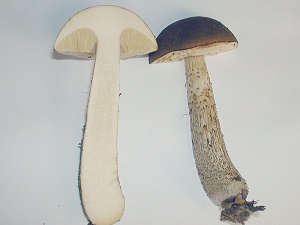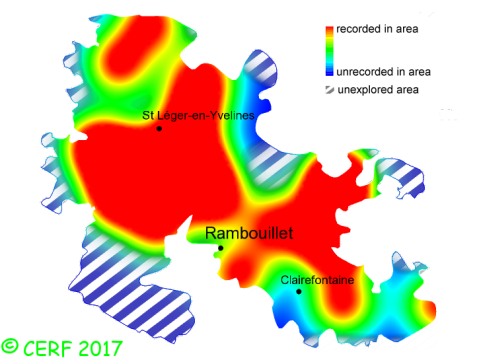| Leccinum scabrum (Bull.:Fr.) S. F. Gray |
|
|
|
|
|
|
The cap is of variable colour, grey-brown, buff, pale brown to dark brown or black, matt, fleshy, initially firm then spongy, of hemispherical shape at the beginning, then convex to flat. The cap surface is downy then smooth, matt if dry, slightly sticky in damp weather, often wrinkled. The cap margin is clean and slightly overhanging tubes, particularly with age. The stem is full, long and firm-tough, rough, covered with longitudinally-arranged scales. It is of more or less equal diameter, or tapering towards the top and thicker at the base. The stem's surface background colour is white to grey, the scales on the stem being greyish, brownish or blackish. The stem gets darker towards the base.. The flesh is thick, firm at first then soon very soft, spongy to watery, the stem being fibrous. It is white, in principle unchanging when exposed to air but sometimes turning pink a bit and very slowly in the upper half, however not turning green-blue in the stem base; its taste is faint or mild; the odour is weak to pleasant, aromatic; The tubes are practically free, or adnate through a groove, thin, long (20-30mm). They are white, then rusty to greyish when maturing, slightly turning pink when cut and exposed to air. The pores are small, round, white then pink then greyish, turning brown/black when pressed (young) or unchanging. The spore print is tobacco brown. It grows in broad-leaved woods, pathsides or wood edges, moors, parks and gardens, in dry as well as wet areas, on a rather acid soil, essentially with birch (also oak, rarely with chestnut). The fruiting period takes place from May to December.
Chemical tests : no reaction (or reddening) of flesh when in contact with formaldehyde; grey to pale blue-grey reaction, without green shades, when in contact to iron sulphate. Distinctive features : Brown cap; tough stem, covered with small black scales; white pores tuning grey; unchanging flesh, or turning very slowly pink when exposed to air; mostly with birch Leccinum scabrum is frequent and very widely present in the forest of Rambouillet, and is frequent, more generally speaking . | ||
|
page updated on 14/01/18

